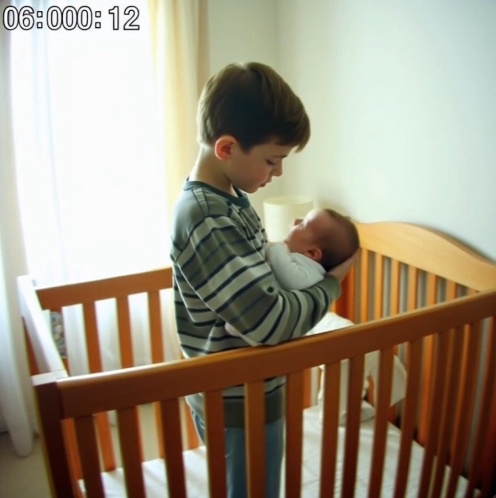Lennox Moles weighed just 800 grams at birth and was delivered prematurely at 25 weeks.
Before being transferred to his incubator, medical professionals at The Royal Women’s Hospital in Melbourne, Australia, quickly placed him in a plastic bag to assist control his body temperature and avoid hypothermia.
Lilly Munro, Lennox’s mother, referred to the newborn’s makeshift residence as a “oven bag” and stated that it was standard procedure for preterm infants who lacked the necessary development to stay warm.
“It is quite confronting image… He was put in a plastic oven-type bag and whisked away,” Ms Munro told Daily Mail Australia.
“It’s what they do in order to preserve [a premature baby’s] temperature because they can’t regulate their temperature.”

Lennox was taken home after 111 days at the Royal Women’s Hospital in Melbourne after his birth.
The survival rate for babies born at this point in the pregnancy is only 50%.
Because of his heroic struggle and survival, Ms. Munro calls her fourth kid her “miracle baby.”
Ms. Munro claimed that around 24 weeks pregnant, she had a “strange feeling that something wasn’t quite right.”
Her doctor made a startling discovery during an ultrasound after she was brought to the hospital.
“My doctor looked at the screen and went, Oh My God… your cervix is open and the baby’s arm is up like Superman through the cervix. You’re not going anywhere,” Ms. Munro told Daily Mail Australia.
‘Lenni’, as his parents call him, was delivered on February 29 following a rigorous seven-hour labor and a week in the hospital.
As his parents juggled raising three other children from past relationships, Lennox fought for his life for four months.
He may require laser surgery because his eyes were not fully grown at birth and he has a hole in his heart.
Lennox, who now weighs 3.5 kg, also had multiple blood transfusions and has respiratory difficulties.
In order to give Lennox the best chance of survival by boosting his immunity, Ms. Munro and her fiancé, Brodie Moles, had to quit their jobs and drive to the hospital every two hours to provide her breast milk.
Instead of heading to his construction job, Mr. Moles took on the role of full-time caregiver for their children while the young mother was in the hospital.
Furthermore, the public hospital system was “so financially stretched” that the couple had nowhere to stay overnight in order to be with Lennox.
The young mother was crying uncontrollably for her baby boy and was unable to eat or sleep at home.
The pair also fell behind on their rent and bills because they were unable to go to work.
Ms. Munro stated that they were still $4,500 behind on their rent and that their electricity had been turned off at the time of Lennox’s homecoming on Monday.
They are not eligible for carer’s allowance or travel aid.
The family has launched a GoFundMe campaign to help pay for these expenses as well as Lennox’s continuing care.
In just one month, the campaign has raised slightly more than $5,000.
Ms. Munro added that she hoped they could spread the word about The Royal Women’s Hospital’s “world-class” newborn critical care unit.
“These doctors are above and beyond… The nurses in here are amazing. Some of them drive from Geelong and from the country [to come to work],” she told Daily Mail Australia.
“They are so passionate about saving these babies and looking after these babies.”
Before being transferred to his incubator, medical professionals at The Royal Women’s Hospital in Melbourne, Australia, quickly placed him in a plastic bag to assist control his body temperature and avoid hypothermia.
Lilly Munro, Lennox’s mother, referred to the newborn’s makeshift residence as a “oven bag” and stated that it was standard procedure for preterm infants who lacked the necessary development to stay warm.
“It is quite confronting image… He was put in a plastic oven-type bag and whisked away,” Ms Munro told Daily Mail Australia.
“It’s what they do in order to preserve [a premature baby’s] temperature because they can’t regulate their temperature.”

Lennox was taken home after 111 days at the Royal Women’s Hospital in Melbourne after his birth.
The survival rate for babies born at this point in the pregnancy is only 50%.
Because of his heroic struggle and survival, Ms. Munro calls her fourth kid her “miracle baby.”
Ms. Munro claimed that around 24 weeks pregnant, she had a “strange feeling that something wasn’t quite right.”
Her doctor made a startling discovery during an ultrasound after she was brought to the hospital.
“My doctor looked at the screen and went, Oh My God… your cervix is open and the baby’s arm is up like Superman through the cervix. You’re not going anywhere,” Ms. Munro told Daily Mail Australia.
‘Lenni’, as his parents call him, was delivered on February 29 following a rigorous seven-hour labor and a week in the hospital.
As his parents juggled raising three other children from past relationships, Lennox fought for his life for four months.
He may require laser surgery because his eyes were not fully grown at birth and he has a hole in his heart.
Lennox, who now weighs 3.5 kg, also had multiple blood transfusions and has respiratory difficulties.
In order to give Lennox the best chance of survival by boosting his immunity, Ms. Munro and her fiancé, Brodie Moles, had to quit their jobs and drive to the hospital every two hours to provide her breast milk.
Instead of heading to his construction job, Mr. Moles took on the role of full-time caregiver for their children while the young mother was in the hospital.
Furthermore, the public hospital system was “so financially stretched” that the couple had nowhere to stay overnight in order to be with Lennox.
The young mother was crying uncontrollably for her baby boy and was unable to eat or sleep at home.
The pair also fell behind on their rent and bills because they were unable to go to work.
Ms. Munro stated that they were still $4,500 behind on their rent and that their electricity had been turned off at the time of Lennox’s homecoming on Monday.
They are not eligible for carer’s allowance or travel aid.
The family has launched a GoFundMe campaign to help pay for these expenses as well as Lennox’s continuing care.
In just one month, the campaign has raised slightly more than $5,000.
Ms. Munro added that she hoped they could spread the word about The Royal Women’s Hospital’s “world-class” newborn critical care unit.
“These doctors are above and beyond… The nurses in here are amazing. Some of them drive from Geelong and from the country [to come to work],” she told Daily Mail Australia.
“They are so passionate about saving these babies and looking after these babies.”

In a deeply emotional and shocking development within the royal family, Kate Middleton, the Princess of Wales, was rushed to the hospital emergency center after fainting for the second time in a matter of weeks. The incident occurred during a private family gathering at Windsor Castle, leaving those present in a state of panic and worry. As paramedics arrived on the scene, King Charles was reportedly seen shedding tears, visibly shaken by the gravity of the situation involving his beloved daughter-in-law.
The entire royal family has been on edge following Kate’s recent health struggles. This latest fainting episode comes amid mounting concerns about her well-being, and speculation about her health has been circulating for some time. However, the situation took a devastating turn when Prince William, in a somber and heart-wrenching announcement, revealed the nature of Kate’s illness: cancer. According to William, Kate has been quietly battling the disease, and her fainting spells are a result of the toll it has taken on her body.
Sources close to the family say that William and Kate have been privately coping with her diagnosis for months, choosing to keep the matter out of the public eye as they focused on her treatment. However, as her condition has worsened, it has become increasingly difficult to conceal the reality of her illness. William’s announcement about Kate’s cancer diagnosis confirmed the worst fears of many royal observers, sending shockwaves through the nation.
King Charles, who has always shared a special bond with Kate, was reportedly overcome with emotion upon learning the full extent of her illness. According to insiders, he has been a constant source of support for both William and Kate during this difficult time, but the gravity of the situation has hit him hard. Witnesses described how Charles wept openly as Kate was taken by ambulance to the hospital, knowing the challenges that lie ahead for her and the family.
The public has also reacted with an outpouring of concern and sympathy for the Princess of Wales. Kate, known for her grace, resilience, and unwavering commitment to her royal duties, has long been a beloved figure within the monarchy. News of her illness has left the nation heartbroken, with many taking to social media to express their well-wishes and prayers for her recovery.
As Kate was rushed to the emergency center, Prince William remained by her side, visibly distraught but determined to stay strong for his wife and their children. Medical professionals have not yet disclosed the specific type of cancer Kate is battling, but William’s statement suggested that the family is preparing for an intense and prolonged fight against the disease. With the royal household thrown into uncertainty, the focus is now on supporting Kate through her treatment and ensuring she has the best care possible.
Kate’s condition has also raised concerns about the future of the monarchy, as she plays an integral role in shaping its image and ensuring its continuity. Her health crisis comes at a critical time for the royal family, with many wondering how they will navigate the challenges ahead without her active presence in public life. However, both William and King Charles are reportedly committed to maintaining stability within the monarchy while prioritizing Kate’s recovery.
For now, the royal family remains tight-lipped about the specifics of Kate’s treatment plan, but the nation is undoubtedly holding its breath as they await further updates on her condition. As King Charles, Prince William, and the rest of the family rally around Kate, the hope remains that she will find the strength to overcome this devastating illness and continue her vital role within the royal family
When people dry their clothes outside, especially in sunny weather, it is not uncommon for insects to be drawn to them. One surprising and sometimes alarming situation is discovering bees on freshly washed garments, including underwear. This can cause confusion and concern, but there are natural explanations behind this behavior. Why Bees Are Attracted to Laundry Bees are naturally curious
creatures that rely on their sense of smell to locate food sources and communicate with their hive. Clean laundry, especially light-colored clothing, can sometimes mimic certain natural cues that bees associate with flowers or nectar. Here are some common reasons why bees may gather on clothes: Fragrances from Detergents and Fabric Softeners Many detergents and softeners contain floral or fruity scents that resemble the fragrance of blossoms. Bees, mistaking these scents for flowers, may land on the fabric in search of nectar. Moisture on the Fabric Bees sometimes seek out water to cool their hive or to dilute stored honey. If clothes are still slightly damp, bees might approach them as a potential

source of moisture. Bright and Light Colors Bees are more attracted to bright and light shades, such as white, yellow, or pastel colors. These tones resemble flowers in nature, making laundry a potential landing spot. Heat Retention Clothes warmed by the sun can give off a gentle heat that attracts bees, especially if they are searching for warmth in cooler conditions. Is It Dangerous? While bees are not naturally aggressive, discovering them on intimate clothing can be startling. If disturbed, they may sting in self-defense. To reduce risks, it’s important to handle such situations calmly. Avoid shaking or swatting the fabric, as this can agitate the bees. What to Do If You Find Bees on Your Clothes Wait until they leave naturally. Bees often fly away once they realize there is no nectar. Gently move the clothing indoors. If possible, use a stick or hanger to lift the garment without direct contact. Avoid scented

laundry products. Opt for fragrance-free detergents and softeners to reduce attraction. Dry clothes indoors during peak bee activity. Midday is when bees are most active; drying laundry indoors can help. Preventive Measures Use unscented or hypoallergenic detergents. Shake clothes well before bringing them indoors. Dry laundry under a shaded or screened area to minimize exposure. Consider installing a
mesh barrier around outdoor drying spaces if bees are frequent visitors. Final Thoughts Although it can be surprising to find bees gathered on laundry, including underwear, it is usually harmless and caused by fragrances, moisture, or color. By taking simple precautions, you can avoid such situations and ensure your clothes remain bee-free. Remember, bees play a vital role in our ecosystem, so treating them with care and respect benefits both humans and nature.
creatures that rely on their sense of smell to locate food sources and communicate with their hive. Clean laundry, especially light-colored clothing, can sometimes mimic certain natural cues that bees associate with flowers or nectar. Here are some common reasons why bees may gather on clothes: Fragrances from Detergents and Fabric Softeners Many detergents and softeners contain floral or fruity scents that resemble the fragrance of blossoms. Bees, mistaking these scents for flowers, may land on the fabric in search of nectar. Moisture on the Fabric Bees sometimes seek out water to cool their hive or to dilute stored honey. If clothes are still slightly damp, bees might approach them as a potential

source of moisture. Bright and Light Colors Bees are more attracted to bright and light shades, such as white, yellow, or pastel colors. These tones resemble flowers in nature, making laundry a potential landing spot. Heat Retention Clothes warmed by the sun can give off a gentle heat that attracts bees, especially if they are searching for warmth in cooler conditions. Is It Dangerous? While bees are not naturally aggressive, discovering them on intimate clothing can be startling. If disturbed, they may sting in self-defense. To reduce risks, it’s important to handle such situations calmly. Avoid shaking or swatting the fabric, as this can agitate the bees. What to Do If You Find Bees on Your Clothes Wait until they leave naturally. Bees often fly away once they realize there is no nectar. Gently move the clothing indoors. If possible, use a stick or hanger to lift the garment without direct contact. Avoid scented

laundry products. Opt for fragrance-free detergents and softeners to reduce attraction. Dry clothes indoors during peak bee activity. Midday is when bees are most active; drying laundry indoors can help. Preventive Measures Use unscented or hypoallergenic detergents. Shake clothes well before bringing them indoors. Dry laundry under a shaded or screened area to minimize exposure. Consider installing a
mesh barrier around outdoor drying spaces if bees are frequent visitors. Final Thoughts Although it can be surprising to find bees gathered on laundry, including underwear, it is usually harmless and caused by fragrances, moisture, or color. By taking simple precautions, you can avoid such situations and ensure your clothes remain bee-free. Remember, bees play a vital role in our ecosystem, so treating them with care and respect benefits both humans and nature.

The sun was setting, casting a warm golden glow over the lush garden where the wedding ceremony was taking place. Laughter and soft music filled the air as guests mingled, sipping champagne and admiring the beautiful floral arrangements that lined the aisle. The bride, Emily, looked radiant in her ivory gown, the delicate lace shimmering with every step she took. Beside her stood her groom, Ryan, his eyes filled with adoration and love as they exchanged vows.
As the officiant pronounced them husband and wife, the crowd erupted into applause, the joyous sound echoing through the garden. Emily and Ryan turned to walk down the aisle together, their hands tightly clasped. Everything was perfect, a fairy tale wedding come to life. But just as they reached the middle of the aisle, a ripple of movement caught everyone’s attention.
A collective gasp spread through the crowd as something began to stir beneath Emily’s voluminous skirt. Ryan’s face turned pale, his expression shifting from joy to confusion and then to concern. The guests murmured, craning their necks to get a better look, their curiosity piqued and their imaginations racing.
Emily paused, a look of bewilderment crossing her face. She glanced at Ryan, who was now visibly anxious, his brow furrowed. The officiant, standing at the altar, hesitated, unsure whether to intervene or let the spectacle unfold. The murmurs among the guests grew louder, a mix of surprise and amusement.
Then, to everyone’s astonishment, a small, furry creature emerged from beneath Emily’s dress. It was a kitten, its tiny body covered in soft, white fur that blended almost perfectly with her gown. The kitten seemed unfazed by its dramatic entrance, its bright eyes blinking up at the gathered crowd.
Laughter erupted, a wave of relief and delight washing over the guests as they realized what had happened. Ryan let out a breath he hadn’t realized he was holding, a smile breaking across his face. Emily, too, began to laugh, bending down to scoop up the unexpected intruder.
“Well, it looks like we have a little wedding crasher,” Emily said, cradling the kitten in her arms. The guests chuckled, their laughter a musical accompaniment to the gentle rustling of leaves in the breeze.
The mystery of the kitten was quickly solved. Earlier that day, as Emily was getting ready, her niece had been playing with the kitten in the room where the bride’s dress was hanging. In the excitement of the preparations, the kitten had snuggled into the folds of the gown, unnoticed by anyone.
As the laughter died down, Emily and Ryan continued down the aisle, the kitten nestled comfortably in her arms. The guests followed them to the reception area, where the celebration continued with renewed joy and a new, unexpected guest.
Throughout the evening, the kitten became the star of the show, charming everyone with its playful antics. Emily and Ryan decided to adopt the little creature, seeing it as a serendipitous symbol of their new life together. As the night drew to a close, the couple stood together on the dance floor, the kitten purring contentedly in Emily’s arms. It was a wedding day they would never forget, made even more special by the tiny, unexpected guest who had stolen everyone’s hearts.

The atmosphere outside the police station was tense.
Flashing lights reflected off nearby buildings as a uniformed officer was escorted out in handcuffs. Reporters called out questions, cameras clicked in rapid bursts, and passersby held up their phones to capture the scene.
It looked, from the outside, like the conclusion of a serious incident. But behind the walls of the station, one security camera continued to record — and the footage it captured would soon reshape the way many saw the story.
The Private Moment Before the Headlines
According to the time stamp, the video was taken just minutes before the officer was formally taken into custody. He was alone in a holding room, still wearing his uniform.
At first, the recording showed nothing unusual — just the officer pacing a few steps, pausing, and glancing toward the door. He seemed restless, perhaps nervous. Then, he sat down, leaned forward, and reached into his pocket.
From it, he pulled a small, worn photograph. He studied it for several seconds before pressing it to his lips in a brief kiss. The camera’s microphone picked up a faint whisper: “Tell them I was trying to protect her.”
The photograph, later confirmed by officials to be of his young daughter, instantly shifted the public perception of the unfolding case.
From Investigation to Questions
Initial reports had stated that the officer was facing allegations of interfering with an ongoing investigation. No further details were immediately available, leaving the public to speculate.
However, after the footage surfaced online, many began to wonder if the incident was as straightforward as it first appeared. Was this a case of a law enforcement officer stepping outside proper procedures for personal reasons? Or was it, as some suggested, a father making a difficult and emotional choice under pressure?
The Public Reacts
The clip, once posted online, spread rapidly across social media platforms. Within hours, it had been viewed millions of times and attracted thousands of comments.
Viewers seemed deeply divided. Some argued that, regardless of personal circumstances, laws and protocols must be followed, especially by those entrusted with public safety. Others expressed sympathy, noting that the footage portrayed someone torn between duty and family.
Many admitted that the emotional weight of the moment — the photograph, the whispered words — made the situation far more complex than the headlines suggested.
An Unfinished Story
Authorities have confirmed that the investigation is ongoing, and full details have yet to be released. Until then, public opinion continues to sway between two competing narratives:
One of a police officer accused of breaching his duty.
Another of a parent who believed he was acting in the best interest of his child.
Whatever the outcome, the video remains a powerful reminder that behind every uniform, badge, or title, there are human stories — stories filled with choices, consequences, and moments that few expect to be seen.
And this time, the world is watching.

The young family lived in a cozy suburban home, surrounded by the whispers of nature and the gentle hum of early mornings. Life had a rhythm here, a comforting predictability that embraced the young parents and their two sons. Yet, beneath the surface of this serene facade, an unexpected ritual unfolded each day, one that left the parents in a state of growing curiosity and concern.
Their eldest son, a bright and compassionate eight-year-old, had developed an unusual habit. Every morning, as the clock hit the stroke of six, he would awaken without the aid of an alarm. With the quiet of a seasoned night prowler, he would tiptoe across the wooden floors, tread past the hallway, and enter his younger brother’s room.
At first, the mother chalked it up to sibling affection—a bond so strong that it defied the boundaries of sleep. She often found herself smiling at the scene, her eldest cradling the baby with a tenderness that belied his years. Yet, as this routine repeated with unwavering precision, a nagging question nestled itself into the corners of her mind. Why six o’clock, and why with such steadfast regularity?
Days turned into a week, and the mother’s curiosity swelled into unease. Her husband, too, shared her intrigue, though he was more inclined to let the mystery unravel itself naturally. But the mother, spurred by a blend of curiosity and maternal instinct, decided she needed to understand what drove her son’s early morning excursions.
Determined to uncover the truth, she awoke before the sun one chilly morning. She wrapped herself in a robe and positioned herself at a vantage point where she could observe without being seen. As the digital clock on her nightstand flickered from 5:59 to 6:00, her son stirred, just as he had each day prior. His movements were deliberate yet gentle, as if he were part of a silent ballet.
The mother followed at a discreet distance, her heart a medley of anticipation and trepidation. She watched as her son entered the nursery, approached the crib, and lifted his younger brother with an ease that spoke volumes of his experience. As the baby nestled against him, the eldest son stood still, gazing out the window at the awakening world.
Overcome with a blend of emotions, the mother finally spoke, her voice a gentle whisper in the quiet room. “Son, why are you doing this?”
Her son turned, eyes wide, caught between the innocence of youth and the burden of his secret. There was a pause, a breath in which time seemed to hold its breath. Then, in a voice just above a whisper, he replied, “I have to make sure he starts the day with a hug. I heard that hugs make you grow strong and happy, and I want him to feel that every morning.”
The mother’s initial shock gave way to a profound sense of awe and love. Here was her son, in his own earnest way, ensuring that his little brother began each day wrapped in warmth and affection. It was a revelation that spoke to the depth of their bond, one unclouded by the complexities that often shadow adulthood.
The parents, having unlocked the mystery, found themselves enveloped in gratitude and pride. Their sons, bound by love and the innocence of childhood, were teaching them a lesson as ancient and profound as the dawn itself: that in the simplicity of a hug, a world of care and connection blossoms.

In a heart-stopping moment captured just seconds before a tragic accident, the Air India pilot’s frantic mayday call has been revealed, shedding light on the intense pressure and dire circumstances faced in the cockpit. Passengers onboard the ill-fated flight were unaware of the drama unfolding in the cockpit as the pilot made a desperate plea for assistance.

The mayday call, filled with urgency and fear, underscores the challenges pilots can encounter even with advanced training and technology at their disposal. As investigators analyze the black box data and cockpit voice recordings, the pilot’s calm yet urgent communication paints a vivid picture of the situation.

Experts in aviation safety emphasize the importance of such calls, as they provide crucial information that can assist in understanding the sequence of events leading to an accident. This particular call is a stark reminder of the unpredictability and potential danger inherent in air travel.

Ongoing investigations aim to piece together the final moments of the flight, using the pilot’s mayday call as a pivotal piece of evidence. As families and friends of those affected seek answers, the aviation community is once again reminded of the critical role communication plays in ensuring passenger safety.

As I sat at the dining table, staring blankly at the files sprawled in front of me, my mind struggled to comprehend the situation unfolding with my daughter, Sophie. The clinical environment of my job as a police officer often desensitizes one to the horrors of the outside world. Yet, nothing prepared me for the shock of discovering such harsh realities within my own family.
Sophie was now asleep in her room, the gentle rise and fall of her small body a temporary balm to my racing thoughts. The marks on her back were more than physical scars to me; they were a testament to the emotional turmoil and the loss of innocence she was being subjected to under Nathan’s so-called ‘training.’
My mind began to navigate through the procedural steps, a methodical approach ingrained in me after years on the force. I knew my next steps legally, but emotionally, I found myself grappling with a storm of emotions. How could Laura not see what was happening? Had our differences in parenting philosophies blinded her to the reality of her husband’s actions?
I reached for my phone and dialed the number for Child Protective Services. The conversation was brief, factual, and professional. I explained the situation, detailing the evidence gathered, and underscored the urgency of the matter. It was a call no parent ever wishes to make, but it was a necessary one. Sophie deserved to feel safe; she deserved a childhood unmarred by fear and pain.
After the call, I sat back and thought about the future. I knew there would be investigations, legal proceedings, and likely a custody battle. But I also knew that inaction was not an option. My role as a father meant protecting Sophie at all costs, ensuring her world was one of love and security, not fear and pain.
As the days passed, I spoke to Laura again, this time with mediators present. She remained defensive, her loyalty to Nathan blinding her to the evidence at hand. It was heartbreaking to watch the woman I once loved placing misguided trust in someone who was causing harm. But as much as I wished for cooperation, I prepared for conflict.
Through it all, I kept Sophie’s well-being at the forefront. We spent more time together, doing things she loved—painting, visiting the park, playing with our dog Max. My goal was to rebuild her confidence, to remind her of the strength and resilience that lived within her.
In the end, the term ‘toughening up’ had a new definition for me. It wasn’t about enduring unnecessary hardship or pain; it was about having the courage to stand up against what’s wrong, no matter how close to home it hits. Sophie’s situation reminded me of the power of evidence—not just in my professional life, but in personal spheres where it can profoundly change lives.
As I watched Sophie regain her confidence, her laughter slowly returning to replace the silence, I realized this fight was as much for her as it was for any child caught in such harsh circumstances. Evidence had shown me the truth, and with it, I was determined to ensure Sophie’s world was one where she felt strong, loved, and, above all, safe.
In a heartfelt and emotional plea, Prince William has publicly reached out to his younger brother, Prince Harry, asking for forgiveness and urging him to return to the royal family. This surprising move comes amidst growing concerns over the royal family’s unity in the wake of King Charles’s serious illness. Prince William, known for his usually stoic demeanor, reportedly showed a rare vulnerability in a private message to Harry, acknowledging the rift that has separated them for years.

Sources close to the royal family reveal that Prince William, deeply moved by the situation and the gravity of his father’s health issues, recognized the need for reconciliation. “Brother, I was wrong to you,” William is said to have written in his message to Harry. The words carry a heavy weight, as they mark a significant shift in the relationship between the two brothers, who have been at odds for some time over personal and public matters.
William’s apology and call for Harry’s return to the family come during a time when the royal family is facing a potential crisis with King Charles’s health. The ongoing tension between the brothers has added strain to an already difficult situation, and insiders suggest that William’s decision to take the first step toward reconciliation is driven by both family loyalty and a sense of urgency.
The request for Harry to come back is reportedly filled with emotion, with William expressing regret for the public feud that has plagued their relationship. Sources indicate that William’s words were not only an apology for past mistakes but also a plea to heal the rift for the sake of the family, especially as the royal family faces an uncertain future.
Prince Harry, who has been living in the United States with his wife, Meghan Markle, has yet to respond to his brother’s heartfelt message. While it is unclear whether he will accept the invitation to return to the family, the gesture is seen as a significant step toward mending their fractured relationship. Both brothers are under immense pressure, and this appeal may be the beginning of a long and difficult path toward reconciliation.
As the situation continues to develop, the royal family and the public await Harry’s response. The coming days could determine not only the future of the relationship between Prince William and Harry but also the future dynamics within the royal family as they navigate personal and public challenges.

Sources close to the royal family reveal that Prince William, deeply moved by the situation and the gravity of his father’s health issues, recognized the need for reconciliation. “Brother, I was wrong to you,” William is said to have written in his message to Harry. The words carry a heavy weight, as they mark a significant shift in the relationship between the two brothers, who have been at odds for some time over personal and public matters.
William’s apology and call for Harry’s return to the family come during a time when the royal family is facing a potential crisis with King Charles’s health. The ongoing tension between the brothers has added strain to an already difficult situation, and insiders suggest that William’s decision to take the first step toward reconciliation is driven by both family loyalty and a sense of urgency.
The request for Harry to come back is reportedly filled with emotion, with William expressing regret for the public feud that has plagued their relationship. Sources indicate that William’s words were not only an apology for past mistakes but also a plea to heal the rift for the sake of the family, especially as the royal family faces an uncertain future.
Prince Harry, who has been living in the United States with his wife, Meghan Markle, has yet to respond to his brother’s heartfelt message. While it is unclear whether he will accept the invitation to return to the family, the gesture is seen as a significant step toward mending their fractured relationship. Both brothers are under immense pressure, and this appeal may be the beginning of a long and difficult path toward reconciliation.
As the situation continues to develop, the royal family and the public await Harry’s response. The coming days could determine not only the future of the relationship between Prince William and Harry but also the future dynamics within the royal family as they navigate personal and public challenges.

As I lay motionless, trying to control my ragged breathing, I could hear my heart pounding in my ears. The man—a stranger, yet disturbingly familiar—was now in my personal space. My chest tightened with fear, and I squeezed my eyes shut, hoping against hope that he wouldn’t discover my hiding place.
My mind raced. Who was this intruder, and how did he have access to my home? More importantly, how did he know my name? The questions swirled in my head, each more unsettling than the last.
The man continued to rummage through my belongings, his movements deliberate yet careless, as though he was righting something he felt was wrong. Papers rustled, drawers opened and closed, and I could hear him muttering to himself, his words just out of reach. Straining my ears, I caught fragments of his musings—something about keeping the place in order and maintaining appearances. It was as though he was on a mission, but I couldn’t fathom what that mission might be.
Minutes felt like hours as I lay there, paralyzed by uncertainty and fear. I began to question my own reality, wondering if perhaps I’d slipped into some surreal nightmare. Had I met this man before? Was he someone from my past, or a figment of my imagination brought to life by stress and fatigue?
Then, just as suddenly as he had arrived, the man’s presence began to fade. His footsteps retreated down the hallway, and I heard the front door open and close once more. Silence returned, but it was a silence that roared with unanswered questions.
For several long minutes, I stayed hidden, trying to calm my racing heart and gather my courage. Once I was certain I was alone, I slowly crawled out from under the bed. My limbs were stiff, and my mind was still reeling from the encounter. I tiptoed through the house, checking every room, every corner, to ensure the man was truly gone. Each room appeared just as I had left it, aside from a few moved papers and slightly ajar drawers.
I couldn’t shake the eerie familiarity of the man’s voice, the way he moved through my home as if he belonged there. It sent chills down my spine. I needed answers—needed to understand what was happening in my own home.
Determined, I decided it was time to take further action. I installed additional locks on every door, set up security cameras throughout the house, and even changed the codes on the alarm system. But the pervasive unease lingered, a constant reminder of the intrusion.
I began to dig into my own past, searching for connections, explanations—anything that could provide clarity. I interviewed neighbors, hoping to catch a glimpse of the mysterious man when I reviewed the footage. Days turned into weeks as I combed through old photos, emails, and personal records.
The quest for understanding consumed me, as I lived in a constant state of vigilance and paranoia. Yet, the more I investigated, the more elusive the truth became. It was as if the man was a ghost, slipping through my grasp just when I thought I was close to discovering his identity.
Though I never encountered the intruder again, the experience left an indelible mark on my life. I moved forward, more vigilant and wary, but still haunted by the mystery of the man who knew my name and the secrets he carried with him.
 Top Video Viral
Top Video Viral